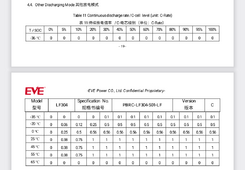iClick
New Member
I'm building a simple 12v battery for a DIY toolbox power station. I've ordered 4 x EVE LF304 cells and I've also ordered a 300A BMS JK-B2A8S30P
The planned configuration is a simple 4S1P which will give me 12.8v and 304A however I've only just realised by reading the specs (attached below) that these cells are only rated at 0.5 C continuous charge/discharge rate.
Does that mean I will be limited to drawing only 152A continuously from this configuration if I want to stay within the manufacturers specs?
And if I want to double the discharge rate to utilise the 300A BMS, will I have to add another four cells and use 2P4S configuration?
The planned configuration is a simple 4S1P which will give me 12.8v and 304A however I've only just realised by reading the specs (attached below) that these cells are only rated at 0.5 C continuous charge/discharge rate.
Does that mean I will be limited to drawing only 152A continuously from this configuration if I want to stay within the manufacturers specs?
And if I want to double the discharge rate to utilise the 300A BMS, will I have to add another four cells and use 2P4S configuration?




